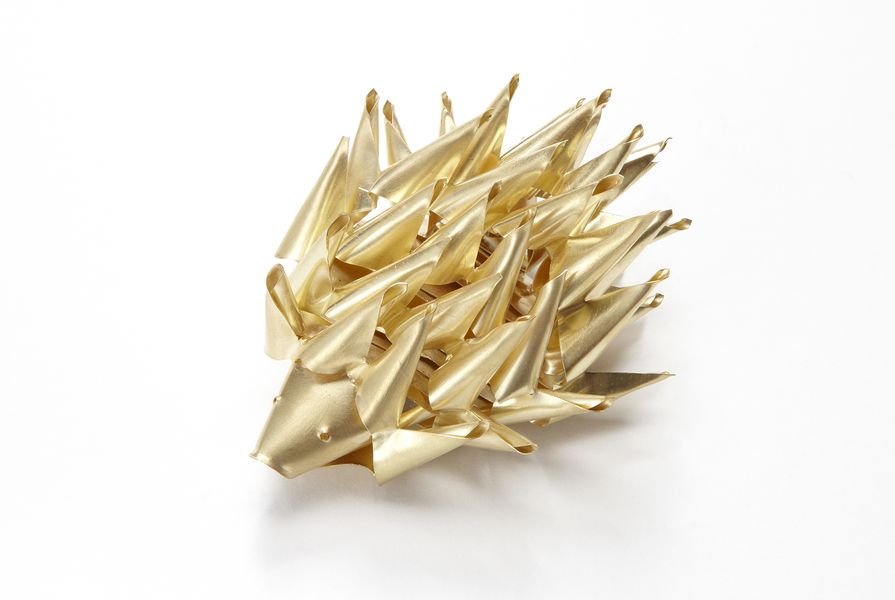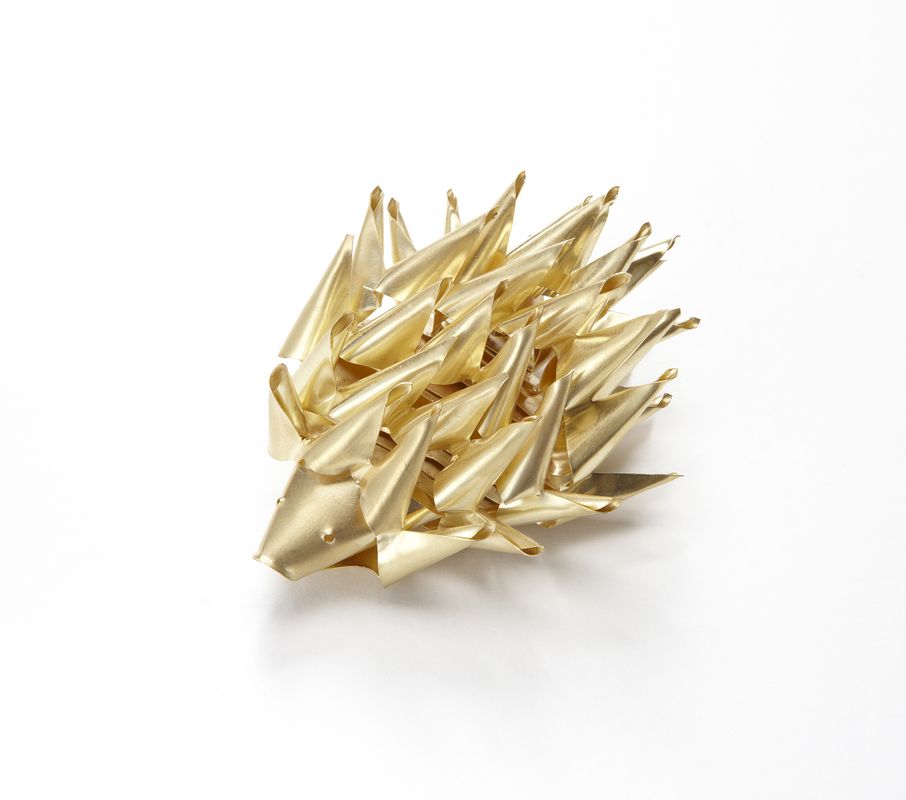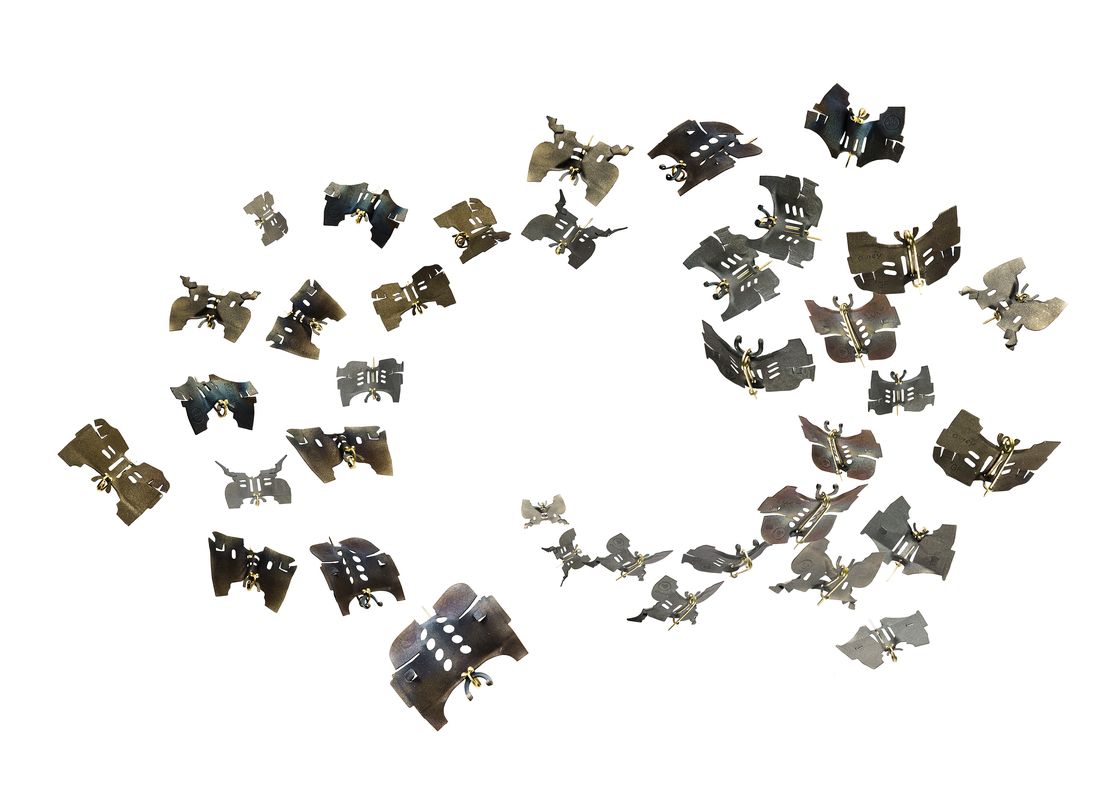I wish David Bielander’s new show at Gallery Funaki was titled in German using one of those words, like Gestalten or Zeitgeist, which drip with inference and association, making them impossible to translate because there is no parallel for them in our language. That’s not because I love obfuscation, quite the contrary, it’s because highly nuanced words, when appropriately used, convey all that the little and not so little objects in this gallery space promise and deliver on.
This is something Bielander knows all too well. On the weekend, in a contemporary jewellery master class, he conducted at RMIT, he talked about Inszenierung – a word closest to the French mise en scene meaning both setting up a work and directing a performance or public display – to make the point that the work of an artist must be to communicate with an audience through the way the work is presented as well as through the object itself.
However, the word ‘escapade’, the title of David Bielander’s new exhibition, suggests quite the opposite to an immersion into difficult foreign concepts. I would imagine he chose it especially because it’s more appropriate to our shores and to the Australian predilection (and his too, it seems) for irreverence, romp, riot, breakout and adventure. In Melbourne, at least, the difficult and the irreverent or the serious and the humorous don’t seem at all at odds with each other and so it must be said that the precision inherent in the crafting of his objects, the inevitability of his choice of techniques, the materials he employs and the rigour he applies to the conceptual framework, in which the objects exist, come very happily together in the show. ‘Okay’, you might say, ‘so he knows what he’s doing!’ Yes that obvious enough, but only once it’s in front of us.
The things Bielander talks about in his workshops, where he gives his students feedback on their work, are what he calls ‘facts’ not the facts one would report in a newspaper (perhaps wrong choice of word here) or more appropriately in a scientific report, but never the less objective statements about design.
In a world that thinks great art and good design are a matter of opinion he makes it clear that while we may not be able to explain a great work of art in words (why would one make it if we could just as equally describe it in words) we can recognize (sooner or later) its ‘rightness’. The ‘facts’ that make it so may not be universal truths but he says ‘I expect someone to argue convincingly for their own point of view if they don’t agree with me’.
This requires a deep understanding of history, theory, knowledge of craft techniques and the potential of materials which in Bielander’s case was acquired over a long journey through apprenticeships in renown studios, a degree at the Akademie der Bildenden Künste in Munich where he studied with Prof. Otto Künzli, and also while teaching at the Burg Giebichenstein University of Art and Design Halle in Germany and consulting for the Gerrit Rietveld Academie in Amsterdam, something he does to this day.
Demiurge, 2013, c-type print.
Image: Simon Bielander
It’s inevitable therefore that Escapade works on so many levels. The photograph, Demiurge, (a self-portrait by Simon and David Bielander) sets the scene. Produced in 2013 for the exhibition organized on the occasion of David Bielander receiving the Françoise van den Bosch Award (the ‘Pritzker Prize’ of contemporary jewellery), the image depicts him in a classic head and shoulder portrait in the manner of the 16th Century Italian Giuseppe Arcinboldo’s allegoric portraits. These were composed of fruits and vegetables, animals and objects; in the likeness of his noble masters. Bielander’s on the other hand is a self-portrait assembled from his own art works: Pearl Pig (Perlsau) brooch and Wiener, a sausage-shaped necklace, made from Thonet bentwood chair parts, amongst others.
Next to the portrait is a mysterious little black pouch hanging from a hook, titled Smoke Ring. This work is an elaborate but deadly serious hoax, beautifully conceived and executed. In his early career Bielander constructed a smoke machine which could blow rings, the size suitable for a ring finger, as a means of making ‘unwearable’ jewellery. The pouch hanging on Funaki’s wall contains one such ring which was produced as a series of 100 by his re-making of the smoke machine for the Demiurge exhibition, at the Museum voor Moderne Kunst Arnhem (MMKA), just ended in January this year.
Aside from this ephemeral work the very real Grinder rings, in 3D printed polyamide, some with silver and gold ‘fillings’, are a visual joke about the cost of dental repair and those who can afford it. Hannibal (baby) the remake of a North African teapot, in the manner of the many ‘fair trade’ artefacts which now crowd European street markets, takes us back to that earlier conquest of Europe by the north African warrior of the same name.
Octopus/Kraken, 2012 (edition of 25), bronze.
Image: Dirk Eisl
The Octopus candelabra are a beautifully conceived table centre-piece in bronze reminiscent of the decorative arts figurines popular in 19th century Vienna. By arranging each branch of the candelabra closer or further apart I am able to expand the submerged creature’s imagined size, putting a smile on my face, adding the candles gives it a further humorous impulse. However this action is only optional, demonstrating Bielander’s ability to solve the candelabra’s ‘design problem’, which is to make this object ‘complete’ without the candles.
The works I describe are part of a relatively recent phenomena in contemporary art starting somewhere in the 1960s, however its roots in the traditional jewellery and silver smithing crafts lend it a rich tradition. For a time Bielander wanted to deny that tradition or at least the very rigid extremes his craft had become trapped in. After building the first smoke machine in the ’90s he worked exclusively for a time with readymade objects thus finding his very own working method. Koi, Corncob, Moths and Bat are all examples of his way of working and thinking. The Koi fish scales are made with multi-coloured drawing pins, Moths and Bat are his reworking of cigarette lighters’ metal casings, while the corn kernels of Corncob are fashioned from the heads of brass spilt pins purchased at a stationeries supplier.
David Bielander’s world is made up of ideas which manifest themselves into objects. His art is a virtuoso performance in the use of materials and techniques. All sorts of materials; from the titanium and gold he uses in Mamba, a metre-long necklace in the shape of a snake, to the plastic tubing which he combines with a commercial silver chain in Raspberries, and all sorts of techniques; from the 3D printing of the ‘giant molars’ which he transforms into rings, to the rolling of the thin sterling silver sheet with which he makes Garlic and the shaping of an 18 carat gold flat sheet he uses to fashion Hedgehog. Bielander’s perfect grasp of these objects is what holds our attention and affection.
See Escapade at Gallery Funaki in Melbourne until 26 April 2014.
























